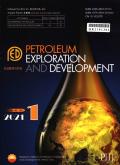Characteristics and hydrocarbon geological significances of paleo-bay in the fourth member of Middle Triassic Leikoupo Formation, western Sichuan Basin, SW China
IF 8
Q1 ENERGY & FUELS
引用次数: 0
Abstract
The depositional facies types of the fourth member of the Middle Triassic Leokoupo Formation (Lei-4 Member) in western Sichuan Basin are examined through the methods of sedimentology, lithology and analysis of well-logging data, as well as the special lithofacies indicators such as microbialite, gypsum-salt rock and tempestites, using the data of about 400 wells and 11 outcrop sections. The distribution and evolution and its hydrocarbon geological significances of the bay facies have been discussed. The Lei-4 Member in western Sichuan Basin has an ocean–bay–flat depositional model, with the presence of evaporated tidal flat, restricted tidal flat and paleo-bay facies from east to west. The subfacies such as bay margin, subtidal bay and bay slope are recognized within the paleo-bay, with microbial reef and grain bank microfacies in the bay margin, microbial flat, deep-water spongy reef and hydrostatic mudstone microfacies in the subtidal bay, and tempestites and collapsed deposits in the upper bay slope. The bay boundary covered the Guangyuan-Zitong-Dujiangyan area in the period of the first submember of the Lei-4 Member (Lei-4-1) with falling sea level, regressed westward into the Shangsi-Jiangyou-Dujiangyan area in the period of Lei-4-2, and expanded to the Shangsi-Zitong-Langzhong- Wusheng-Yanting-Chengdu area in the northern part of central Sichuan Basin in the period of Lei-4-3 along with a small-scale transgression. The topographic pattern of “one high and two lows” is confirmed in the Lei-4 Member, corresponding to a configuration of source rocks and reservoir rocks alternated horizontally and superimposed vertically. Two efficient source-reservoir configuration models, i.e. side source & side reservoir, and self-generating & self-storing, are available with the microbial reef and grain bank reservoirs at the bay margin and the high-quality source rocks within the sags on both sides of the bay. The research findings will inevitably open up a new situation for the hydrocarbon exploration in the Leikoupo Formation.
四川盆地西部中三叠统雷口坡组四段古海湾特征及油气地质意义
利用四川盆地西部地区近400口井和11个露头剖面资料,通过沉积学、岩性学、测井资料分析等方法,结合微生物岩、膏盐岩、风暴岩等特殊岩相指标,对川西地区中三叠统列口坡组四段(列四段)沉积相类型进行了研究。讨论了海湾相的分布、演化及其油气地质意义。川西雷四段为海湾滩沉积模式,自东向西发育蒸发潮滩、限制潮滩和古海湾相。古海湾内发育海湾边缘、潮下湾和海湾斜坡等亚相,海湾边缘发育微生物礁相和粮食滩微相,潮下湾发育微生物滩相、深水海绵状礁相和静水泥岩微相,海湾上部斜坡发育风暴岩和塌陷沉积。雷四段一亚段时期(雷四-1),海湾边界覆盖了广远-子潼-都江堰地区,海平面下降;雷四-2时期,海湾边界向西退至上西-江油-都江堰地区;雷四-3时期,海湾边界扩展至川中盆地北部上西-子潼-朗中-吴胜-盐亭-成都地区,并伴有小规模海侵。雷四段确定了“一高两低”的地形格局,形成了水平上烃源岩和储集岩交替、垂直上叠加的构造。两种高效的源储配置模型:侧源&侧源;侧蓄水池,并自生;海湾边缘的微生物礁和粮滩储层以及海湾两侧凹陷内的优质烃源岩具有自储能力。研究成果必将为雷口坡组油气勘探开辟新的局面。
本文章由计算机程序翻译,如有差异,请以英文原文为准。
求助全文
约1分钟内获得全文
求助全文

 求助内容:
求助内容: 应助结果提醒方式:
应助结果提醒方式:


